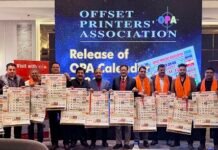
October saw the third outing of the Japan Inkjet Technology Forum (JITF), which has become firmly established as a serious event for the Japanese inkjet community and is becoming increasingly important for many people outside Japan.
The key to this event is that it provides a very good snapshot of the breadth of activity within inkjet, from printheads, components, and inks through to prototypes and print samples as well as software. It’s mainly focused on the industrial end of inkjet as this is where much of the cutting-edge developments are concentrated. The event attracts a broad range of exhibitors, from large players to small startups, as well as visitors from printing companies and academic institutions. And it’s a very democratic event, since every exhibitor has the same small table-sized stand, with everyone mixed together in the same room.

This year’s event had a noticeably more international feel, with exhibitors coming in person from the US, UK and Germany as well as Taiwan, South Korea and China. Naturally many, but not all, of the conference presentations were in Japanese. However, there were also a lot of conversations in English, all of which underline how important the Japanese market is to the global inkjet industry.
The event was founded by Akiyoshi Ohno, who was previously head of Konica Minolta’s inkjet business before setting up his inkjet consultancy. He opened the conference session by saying that Japanese employees did not have much chance to meet staff from other companies noting, “In Japan, I realized that we don’t have many channels to meet other companies. It’s easy to get one-to-one meetings but my target is that many companies can come together under one roof and communicate. It’s not one-to-one but one-to-many and that will create for sure something new, through a new business channel.”

Marco Boer, vice president of IT Strategies, delivered a very thought-provoking keynote presentation on where print manufacturing companies should consider investing their R&D. I’ve already covered this in more detail and you can watch the whole presentation online. He finished up by warning that printers are increasingly likely to have to take back and sustainably dispose of the print jobs once they reach the end of life.
Boer’s presentation was followed by John Spych, vice president of sales for Fujifilm Dimatix, who talked about the new Skyfire SF600 printhead, which is a MEMs head that I have already covered. Questions from the floor covered the range of inks and viscosity that the head can handle. The Skyfire head is being used by some early adopters but will be generally available by the start of next year.
Fujifilm
Fujifilm used its stand to show off its other industrial printheads, including the Starfire and the Samba as well as the new SkyFire. Spych told me that the company was targeting different markets, noting, “Printed electronics is starting to come on, especially in Japan where inkjet is a major focus. Obviously, the Skyfire can play in that market from a stand-off position. But the different regions are all looking at different things.”
He says the corrugated and textile markets are growing: “Pages is the holy grail because of the volume but there are a lot of different segments in pages. We are heavily into ceramics but that’s on a downturn with the building industry.” He added that Dimatix had also seen some demand for printed dashboards and for 3D printing.
Memjet

Memjet appears to be expanding its presence in Japan, having previously relied on distributors DIG. But Memjet now has its own office in Japan, led by Kazumi Honda, regional vice president for Memjet Japan. He says that most of the Japanese OEMs are targeting mid-range to high-end machines, noting: “We are looking for commercial printers, flexible packaging, folding cartons, graphic arts and of course transactional and labels.”
He also talked about Memjet’s new DuraCore printhead, saying that it’s faster and more durable than the existing DuraFlex but still with four colors on one head. The lifetime has now been improved from 1 billion drops with Duraflex up to 4 billion drops with DuraCore. He adds, “In 2026 we will further extend the lifetime to 10 billion drops which is 2.5 times better than today.” Memjet is hoping to improve this to 15 billion drops by 2030.
Honda pointed out that there is very little redundancy in a piezo printhead but that the multiple rows of nozzles within a Memjet head allow for more redundancy. He added, “There’s no need for any kind of compensation because you can jet from the other lines.” Honda continued, “So we have a very strong competitiveness in terms of total cost of ownership.” He claims that even though the head has to be replaced, as all thermal heads do, it is still more competitive than a piezo head.
He added, “We have very tight control of the drop volume with very tight control of the jetting and the drop accuracy of +/- 1-3 microns. We use only water-based ink so the substrate is limited to paper and some types of film.”
He says that Memjet is still developing a white ink and that this may take another two years, noting, “But we are developing for flexible packaging.” Interestingly, he suggests that Memjet will not attempt to develop a new printhead with full nozzle-level recirculation, as HP did with its thermal printhead for its latex printers. Instead, Memjet is looking at an alternative method of dealing with the challenges of white ink and its large titanium dioxide particles.
Konica Minolta
Konica Minolta showed off a new variant on its KM800 printhead. The new KM800-H features a built-in heater. The specifications remain the same as for other heads in the series, with a 56.4mm print swathe. It has two channels but Konica Minolta is not widely promoting this because each channel only gives 180 npi resolution. Used as a single channel head, it can deliver 360 npi, which is the minimum today for most applications. It’s available now with Konica Minolta’s European partner, Industrial InkJet, which is already working with it.
Ricoh

Ricoh mostly showed off the Media-free evaluation test kit and discussed the new company it is setting up in Europe for industrial inkjet projects, both of which I have already covered. However, I think it’s worth noting that even though Ricoh has a large headquarters facility a short train journey away, it still chose to fly out Eiji Tagami, business director of industrial printing for Ricoh UK and Graham Kennedy, general manager of industrial solutions for Ricoh Europe, both based in the UK, which underlines the growing international importance of this event.
Meteor Inkjet
I had an interesting conversation with Clive Ayling, managing director of Meteor Inkjet, which is still best known for developing the electronics to drive all these printheads. He pointed out that although there is a lot of talk about moving towards higher print resolution, there is a lot of additional development required, noting, “1200 dpi is more complex. People buying presses have to put more money in and they have a high expectation that it’s going to be better. So you have to develop it not just so that it works but that it’s better than the 600dpi version. That means the color has to be better, the speed faster, the media handling better – otherwise the customers feel dissatisfied. In a lot of inkjet, you put the drop-down and then it has to spread out to cover an area but with 1200 dpi the ink is already spread out because you are putting more drops down across an area.”
Meteor Inkjet has also developed a range of software, including MetPrint and MetIndustrial, that is aimed at helping industrial users integrate inkjet printing into their processes. Ayling explained, “We have quite a few customers where the printing process is not the main thing that they do. It might be a machine that cuts something into shapes and then jets a varnish on it. So they don’t class it as printing. And for that type of application, the controller of all the activities that go on just wants to see printing as another thing inside the machine. It doesn’t want a printing unit that tells it what to do. It wants to tell the printing unit what to do.”

That in turn implies that the software controlling the printing element will be hidden in the background. He continues, “So MetIndustrial is much more likely to be driven in a headless mode with an interface that can use any software language. So we have the Met Remote Interface where you can use any programming language you like and don’t have to write printing code. That’s all done by Meteor. All the RIP’ing and screening can be embedded inside MetIndustrial. I think that it’s probably going to be one of our most popular software packages in time. We have some beta customers who are testing it now but we think that more and more Meteor customers will pick it up because that’s how they are using inkjet.”
He points out that this can also play a part in converting analog processes to digital: “So in a very large textile machine, if it’s not single pass, you still have a lot of other processes and you might have the MetIndustrial for the printing part.”
He continues, “If you want to look at where the ink volumes will be going you have to look at the new things. We have still to see a great penetration of inkjet into the conventional printing market. So good growth next year will come from places like textiles and corrugated rather than from brand new market areas though the brand new market areas are much more interesting.”
Ayling says that these new things include greater use of robotics, noting, “Automation is a new area, meaning printing where a multi-axis robot is controlling the printing.” He adds, “Normally when you print there’s only one action but automation is when several motors are acting together to get a more complex motion and that’s a far more complicated situation to work out what to do because every drop is going to land in a different place.”
Ayling talked about the value of the JITF event for Meteor Inkjet, saying, “I think that we have always appreciated the opportunity to meet a lot of Japanese companies in the print space. We have quite a significant and long-time presence in Japan in terms of partners and customers, the partners being printhead vendors mostly. So the efficiency of meeting with people is the main reason to be here.”
In the next part of this story, I’ll cover some of the ink suppliers and other component vendors. In the meantime, you can find more details on the event itself from ohno-inkjet.com.
















